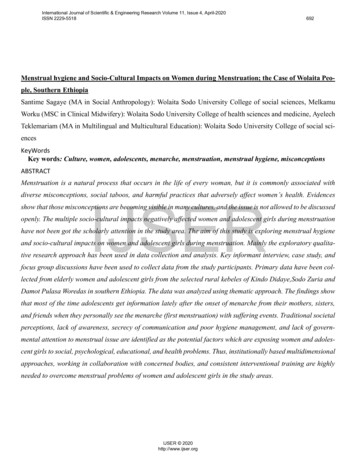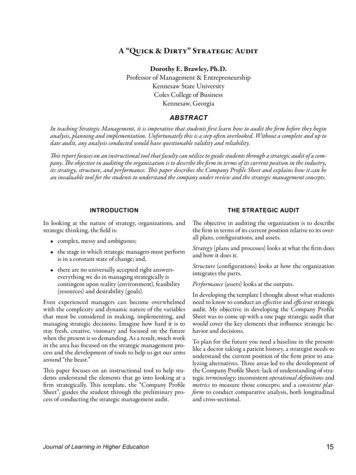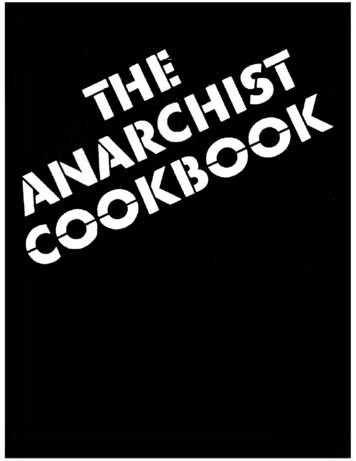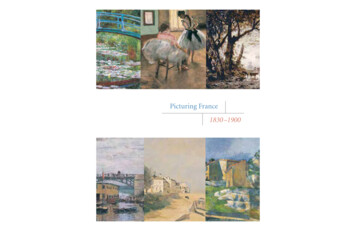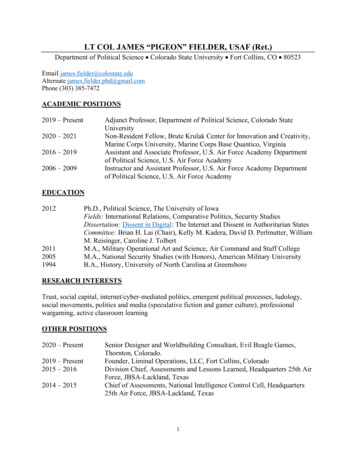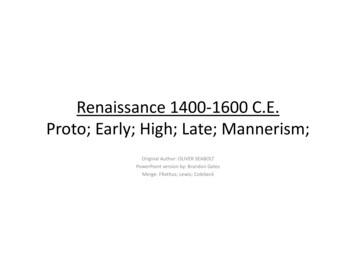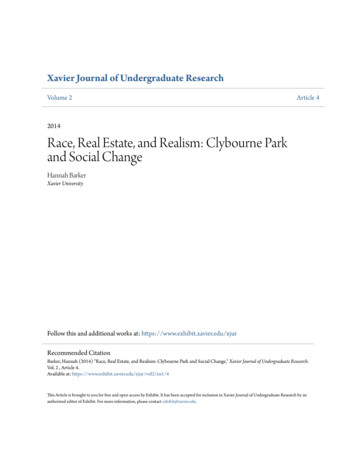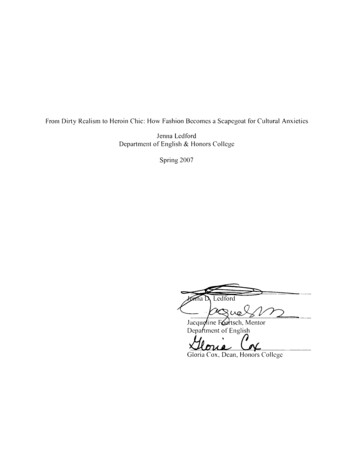
Transcription
From Dirty Realism to Heroin Chic: How Fashion Becomes a Scapegoat for Cultural AnxietiesJenna LedfordDepartment of English & Honors CollegeSpring 2007LedfordJacqueline F ehsch, MentorDepartment of EnglishGloria Cox, Dean, Honors College
Ledford 1From Dirty Realism to Heroin Chic: How Fashion Becomes a Scapegoat for Cultural AnxietiesHeroin chic was a controversial fashion trend duringthe nineties characterized by, but not limited to, models withblank or strung-out expressions, an unkempt appearance,and unusual or contorted body positions, often set againstseedy backgrounds. The look varied across the board fromthe minimalism of Calvin Klein's fragrance and jean ads tothe made-up bruising of models seen on the runway forAntonio Berardi in fall 1997/98, yet all the styles carriedwith them implications of violence, victimization, and selfdestruction. These implications incited many admonitionsFigure 1: One of the most well-knowndepictions of heroin chic. Kate Moss forCalvin Klein fragrance CK Be, c. 1995. http://en.wikipedia.org/wiki/ImagerKateMoss- Calvin Klein%3B be cool.JPG of glamorizing drug abuse, promoting child pornography, encouraging eating disorders, andmocking poverty. Such intense reactions are indicative of the fact that fashion is not simply aby-product of the human need for shielding the body from the elements; rather fashion and thereactions it spawns are often indicators of larger cultural issues. From Flappers to Punks,'straight' society has reacted with indignation to the chosen fashions of their youth and the youthhave used fashion as a means of expressing and communicating differing values or beliefs.Heroin chic was no different, yet it prompted one of the strongest reactions: a federalinvestigation into Calvin Klein, an address by the president, and rallying by various groups toban the images. Such heated reactions indicate a heightened anxiety and tension within societyduring this era that calls for analysis.Beginning with the social context that allowed a space for heroin chic to develop, thisanalysis follows the chronological development of heroin chic throughout the nineties. It looks
Ledford 2at the economic and social factors that led to the creation of an anti-fashion rhetoric, whichspawned a type of photography called dirty realism. Dirty realism's embrace of unconventionalthemes in fashion photography created a space for heroin chic to form. Once the imagery beganto leave the avant-garde and enter the mainstream via Calvin Klein, controversy began to brew,and consequently dirty realism became heroin chic. During its peak, the fashion industry's useof heroin chic imagery became the proof of the moral demise of the younger generations. Uponthe death of heroin chic photographer Davide Sorrenti in 1997, who was misreported as dying ofa heroin overdose, heroin chic experienced a swift demise. Sorrenti's death served to reinforcethe notion that heroin chic reflected a rampant drug problem among America's youth, whichconsequently was an indicator of their moral demise. Ultimately, heroin chic became ascapegoat for the cultural anxieties of an older generation concerned with the uncertainty of afuture for their youth and themselves in a world they helped to create.Heroin chic surfaced during a time of recession, when the assurance of a stable futureeluded much of the younger generation. College graduates were entering a deflated job marketassumedly created by the mistakes of the baby boomers, and the innovations of science andtechnology had not improved their lot as promised. These conditions created a sense ofpessimism and nihilism among this emerging generation and the power dressing of the eightiesno longer suited this new social context. The overt glamour of buxom models like CindyCrawford and Claudia Schiffer sprawled on lush beaches in tropical paradises seemedconstructed lies to the disillusioned Generation X. The fantasy of 1980s fashion imagery did notsuit the sense of hopelessness of this generation. Generation X craved something more authenticin the culture of its time, something that would not create a sense of false hope in them. Theywanted to reclaim the body from the "dictates of fashion" and the "rationality of science"
Ledford 3(Arnold, "Heroin Chic," 286). This demand spawned an era in pop culture obsessed with 'beingreal.' It was under these conditions that punk found a revival, and new movements like grunge,indie kids, and riot grrrl took hold. What all these looks shared was a desire to reject the "yuppiematerialism and the 'health and fitness' craze of the 1980s" (Paglia and Room 10). Grunge,indie rock, riot grrrl, and later heroin chic were all anti-fashion movements; an antithesis to thespectacle of traditional fashion.The 'indie kids' movement emerged in the early eightiesin Britain as a "fusion of punk and leftover hippy aesthetics"(Polhemus 123). Indie kids were often middle-class collegestudents with a dedication to indie rock bands and labels. In thelate eighties-early nineties, during the emergence of bands suchas Nirvana, Pearl Jam, and The Smashing Pumpkins, grungebecame the American version of the British indie-kid style. Bothmovements were marked by over-sized or under-sized clothingFigure 2: Example of 'Kinderwhore'by Courtney Love urtney Love.jpg often from thrift shops, second-hand stores, and army surplusstores: "a middle-class (mis?)interpretation [author's wording] ofthe style of the underprivileged" (Polhemus 122). From this spawned the riot grrrl movement: anindie-punk feminist movement characterized by a fiercely independent, do-it-yourself attitudeand leftist politics. Riot grrrls mixed the opposing styles of overtly sexualized feminine fashions,such as babydoll dresses, lingerie, red lipstick (deliberately smeared), and Catholic schoolgirlelements, with punk and grunge fashions, such as army surplus clothing, leather work boots, andtattoos and piercing. Similar to the riot grrrl look was what came to be known as the'Kinderwhore' look, popularized by such female musicians as Courtney Love of the band Hole
Ledford 4(wife to Nirvana front man Kurt Cobain and well-known for her drug problems) and KatBjelland of Babes in Toyland. All of these movements contained the ideology of punk: defianceof traditional norms and nihilism.With this emerging ideology among the youth, mainstream fashion magazines like Vogueand Harper's Bazaar did not communicate to the younger generation the way they did to theolder generation. Consequently, this opened up a door for alternative culture magazines likeBritain's The Face and i-D, and America's Detour to enter. These magazines with their "hybridconcern with music, film, politics, dance, and fashion" blended high fashion with streetstyle andformed "style journalism" (Breward 128-9). In their article on fashion photojournalism, JohnHartley and Ellie Rennie contended that fashion magazines have replaced weekly, masscirculation magazines like Life as documenters of "contemporary life in pictures" (46). The Facebecame a magazine of style journalism for the alternative culture. The Face founder Nick Loganperfectly epitomized the tone of these magazines when he said: "I wear second-hand clothes andeat cheaply" (Calcutt). Logan understood that there was a gap in the market that needed to befilled. By targeting those who had "grown up in the shadow of punk," these magazines provideda space in which the attitudes and concerns of this disillusioned generation could be expressed"(Jobling 35). They hired young, up-and-coming photographers who shared a similar vision as analternative to the photography seen in mainstream magazines like Vogue. Similarly rejecting theeighties notions of glamour, many of these new photographers wanted to present a "truer imageof young nineties life" (Arnold, "Heroin Chic," 280). This perception that came through in theirphotography came to be called 'dirty realism.'However, dirty realism as a form of fashion photography is inherently flawed due to theconcept of realism within photography itself. Although the photograph depicts concrete images,
Ledford 5it is still skewed by the vision of the photographer (Sontag Regarding the Pain of Others). Thephotographer creates or finds a setting and places an individual, who, in most cases, is aware ofthe presence of the camera, within this constructed setting. In fashion photography, this becomeseven more constructed because the fashion model is trained to pose for the camera. Thephotograph is then cropped in order to hone in on the artist's vision to a greater degree. As is thecase in fashion photography, the photograph is placed within the confines of a fashion magazinewhere the photograph, as a form of artistic expression or cultural transgression, often loses itsoriginal meaning, especially in more mainstream magazines. Stylist for Corinne Day, one of thekey photographers in the promotion of dirty realism, Anna Cockburn said in Imperfect Beauty:"The pictures were out of the context of fashion, they were portraits, in many ways. What madethem fashion was the fact that I was choosing what she wore, the clothes were for sale and theimages ended up in the magazine." (qtd. in Hartley and Rennie 474). Even here the creators ofthe image fall prey to this precarious notion of reality by describing the pictures as portraits,which would indicate they are closer reflections of reality than standard interpretations of fashionphotography: "[.] photography has to abandon its commitment to an objective or evidentialnotion of'the real' even as it continues to strive for 'the truth'" (473).Dirty realism reveled in flaunting the mortality of the body and the mediocrity of theeveryday. Instead of giving the viewer voyeuristic titillation, dirty realism made voyeurismuncomfortable by presenting its viewer with the bleakest aspects of reality: poverty, violence,self-destruction, and banality. Photographers of dirty realism did this in order to "examine andreflect cultural and physical imperfections, instead of constructing a lie of transcendent beauty"(Arnold, Fashion, Desire, and Anxiety 22). A similar revolt occurred mid-century in the work ofsuch photographers as Richard Avedon, Helmut Newton, and Guy Bourdin. These men sought
Ledford 6to break away from the image-makers; the magazines, designers, corporations, etc. Avedondefied the traditional image of the female model (or mannequin as it was known at that time) asemotionless and austere with images of models smiling, laughing, and in action. Newton andBourdin were particularly significant to dirty realism due to their heavy emphasis on violent,erotic, and fetishistic imagery: "They pushed the limits of fashion photography to produceimages that shocked by questioning the foundations of fashion and making intertextualreferences to the other cultural debates" (Craik 109). These artists helped push the boundaries offashion photography to enable a wider cultural dialogue that would allow such looks as dirtyrealism to form.Though not a fashion photographer, apopular influence among dirty realismphotographers was the work of fineart/documentary photographer Nan Goldin. Goldinemerged during the sixties and continues to be anFigure 3: Goldin, Nan. "Greer and Robert on thebed, NYC, 1982." Cibachrome print, 30\40 in.Weinberg, Jonathan and Joyce Henri Robinsons, eds.Fantastic Tales: the Photography of Nan Goldin.University Park, PN: Penn State UP, 2005influential photographer today. He work has oftenfocused on documenting the alternative lifestylesand subcultures of adolescents, punks, gay andtransvestite communities, drug culture, and similar socially transgressive communities. Herwork carried with it themes of sex, violence, addiction, dysfunction, domestic violence, drugs,ADDS, and self-destruction. Goldin particularly focused on her own life. One of her selfportraits depicted her after being beaten by a boyfriend: I want to show exactly what my worldlooks like without glamorization, without glorification. This is a bleak world, but one in whichthere is an awareness of pain, a quality of introspection (qtd. in Weinberg vii). In order to give
Ledford 7an aura of realism and spontaneity, Goldin would often deliberately blur her shots, heighten thecolor with a technique called cibachrome, and utilize a snapshot aesthetic. The snapshotaesthetic would become highly significant in formulating the notion of reality in dirty realismphotography.The snapshot aesthetic and thematic concerns in Goldin's work, combined with thedaring work of Avedon, Bourdin, and Newton, gave dirty realism photographers like CorinneDay, Juergen Teller, and Terry Richardson a space in which to explore their own visions of dirtyrealism. Notably, the social climates of both these eras shared similarities that allowed a spacein which this imagery could briefly flourish. Marred by cultural instability, the sixties emergedas an oppositional reaction to the conservative fifties; much like the nineties, marred byeconomical instability, became a revolt against the more conservative eighties. Punk emerged inthe seventies as a rejection of conformity and a refusal to 'sell-out' to the mainstream, much likeindie kids, grunge, and riot grrrl, which heavily drew on punk ideology. It was under theseconditions that heroin chic found a niche.For the most part, dirty realism images stayed within the realm of the avant-garde andalternative culture magazines where they were appreciated for their authenticity and innovation.In the eighties, the innovative fashion label Commes des Garcons became the first to use this"anti-fashion rhetoric" in their promotions and marketing (Breward 129). Commes des Garconsthough has never been a mainstream label, remaining within the realms of fashion aficionadosdue to their highly conceptual designs. It was not until 1993, when British Vogue hired CorinneDay that controversy began to brew. Rebecca Arnold hit the nail on the head when she describedthis predicament in her analysis of heroin chic: "it is when magazines like Vogue, whichstands for the older generations' more traditional morality, use the style that there is the greatest
Ledford 8outcry" ("Heroin Chic" 291). Fashion photography has always struggled to gain respect as alegitimate art form "with its own aesthetic conventions," but at the same time fashionphotography "had been based on projecting images of femininity in terms of desire" (Craik 92).Consequently, when unconventional fashion photography moves from the realm of the avantgarde to the context of the mainstream fashion magazine like Vogue or Harper's Bazaar it losessome if not all of its original meaning. Hartley and Rennie feel fashion magazines should bepraised because they are "the cheapest and most accessible source of high aesthetic imageryavailable today" (477). Yet, within the context of a traditional fashion magazine, fashionphotography is about selling the clothing and the image the label creates via the construction ofthe fashion photograph, not about the cultural dialogue it may create through its imagery.Day's spread for Vogue called "Under Exposure"depicted an unknown, nineteen year-old Kate Moss frolicking inher underwear. Upon publication, Vogue received a smatteringof criticism. Unlike today, a model in scanty lingerie in amagazine like Vogue was not common fare. In combination withthe pre-pubescent-like figure of Kate Moss, many readers feltVogue was promoting child pornography. British Vogue editor,Figure 4: Day, Corinne. "UnderExposure." British Vogue, 1993. hy/magnify.php?imageid im00250 Alexandra Shulman, stood beside her decision to print thepictures, claiming they were a subversion of the common 'malegaze' and represented a different interpretation of beauty (Jobling 119). The look had yet to befull-blown heroin chic, but it did create a ripple of changes within the imagery of fashion.One of the looks that this publication spawned was the waif look. Designers and labelsloved how clothing hung off the slender frames of lanky models like Moss. Today, one often
Ledford 9hears designers say they want their models to be merely living hangers for the clothing, yet therewas nothing new about the androgynous female figure. In the 1960s, the explosion of the Modlook, which called for a slender frame, shot the model Twiggy to the status of icon. Twiggy wasa marked contrast to the mature, curvaceous female shape of the 1950s much like Moss was tothe 'glamazons' of the eighties. Of course, even the shapely supermodels of the eighties werethinner than the average woman, but a fear of how fashion influenced the psyche of the youngfemale had been building up since the seventies when new social 'epidemic' called eatingdisorders reached national attention.In 1973 Hilde Bruch published her monumental work Eating Disorders, which gave riseto a new area of study for many researchers and cultural analyzers. The problem with a lot ofthese earlier works according to Susan Bordo was their oversimplification of the complexity ofeating disorders. Often development issues, family problems such as the mother/daughterrelationship, and perceptual/cognitive dysfunction were targeted as the sole sources of distortedbody image:Perceptual/cognitive models theorized the role of "sociocultural factors" solely interms of "the pressure towards thinness," "indoctrination by the thin ethic"; whatpassed for cultural analysis were statistical studies demonstrating the dwindlingproportions of Playboy centerfolds and Miss American winners throughout the1980s (45).These earlier analyses failed to examine how the ideal of thinness was perpetuated by Westernculture as a whole; instead they targeted specific institutions, such as the fashion industry, toserve as a scapegoat for such cultural anxieties:
Ledford 10[.] "the media," "Madison Avenue," and "the fashion industry" typically werecollectively constructed as the sole enemy - a whimsical and capricious enemy,capable of indoctrinating and tyrannizing passive and impressionable young girlsby means of whatever imagery it arbitrarily decided to promote that season" (46).In combination with this misconception, the wide-spread reports on rising eating disorders aidedin creating a new cultural crisis. Even the models themselves became targets of criticism forcreating the 'epidemic' of eating disorders among young Western women. In response to theseaccusations, fashion theorist Valerie Steele said: "This [girls looking at Vogue and becominganorexic or boys looking at Playboy and viewing women as sex objects] is such a crude "monkeysee, monkey do" model of human behavior that it is amazing it has achieved such wide currency,except as an ideological response to the equally reductionist instinctual model" (168). In theSeptember 1996 issue of American Vogue, Rebecca Johnson compared letters concerningrepresentations of females within the magazine over the course of three decades. Letters datingfrom the late seventies and eighties praised Vogue for presenting an aspiring ideal, while lettersfrom 1996 harshly condemned Vogue for "portraying sickly thin models as desirable." Johnsonconcluded that: "The model is chosen for her job precisely because she does not look like you orme. She is selected because she is extreme. Extremely pretty and extremely thin" (65). Thisdebate still continues to be played out in Western society today as seen in the recent ban on sizezero models in various European countries. However, as more mainstream companies and labelsbegan adopting dirty realism and taking it to new extremes, the emergence of the waif look wassoon overshadowed by the emergence of heroin chic. One of the first mainstream designers toadopt this new look was Calvin Klein.
Ledford 11In 1993, Calvin Klein hired Kate Moss asthe face for his new youth-oriented perfume CKOne. A series of black and white ads, shot bySteven Meisel, depicted models whose urban dressand abundance of tattoos gave the impressionKlein had recruited them off the street for his newFigure 5: Figure 5: cK One ad, c. 1993 http://www.davidtoc.com/ck/ckad.cfm?Ad ID 75 ad campaign. They were posed like "groupportraits suggesting membership in a cool tribe of urban hipsters" (Elliot, "To be or not to be").In comparison with his Eternity and Obsession ads, the CK One ads clearly targeted the cynicalGeneration X. Klein replaced the high-fashion, fantasy element of his Eternity and Obsessionfragrance ads with the anti-fashion rhetoric of the grunge movement and dirty realismphotography. Klein transformed an anti-fashion rhetoric into a fashion statement in and of itself.For the most part though, the reaction to these ads remained minor in comparison to his later adcampaigns. The few instances of topless women in the ad may have stirred some controversy,but Calvin Klein was already known as this point for his scandalous marketing tactics."Calvin Klein has consistently produced marketing images that have caused uproar, andthe image of his clothing and cosmetics is largely based on a sexuality bordering on the fringe"(Brown and Patterson 37). In 1979, Klein's infamous jeans campaign with a young BrookeShields stating "nothing comes between me and my Calvins" generated uproar. Shields was wellknown for her role as a child prostitute in the 1978 movie Pretty Baby. Shields' reputation incombination with the sexual statement of the ad led some to believe that Klein was promotingchild pornography. In the early eighties, his underwear ads in Times Square, showing malemodels clad only in underwear, incited ire, as well. In response to the indignation prompted by
Ledford 12the 'crotch shots', Klein said "It was done to get attention. I certainly don't want the ads to gounnoticed" ("American Fashion"). In 1986, his commercial for Obsession was banned fromBritish television. The commercial centered on the relationship between a young boy and anadult woman with sexual undertones. In his defense, Klein said "Every small boy has a fantasy,about a school-teacher or even his mother. It was never my intention to do anything in badtaste" ("American Fashion"). By the time of the 1993 CK One campaign, the American public,whether fashion conscious or not, was all too familiar with the eroticism inherent in Calvin Kleinmarketing.In 1994, an advertisementfor Obsession depicting Kate Mosslying naked on a couch broughtCalvin Klein,Klein under fire once again for1Figure 6: Jean ad, 1995. http://www.davidtoc.com/ck/ckad.cfm7Ad I D 219 .IIpromoting child pornography. TheAdvertising Standards Authorityruled the ads irresponsible for "portraying children as sex objects to sell goods" and asked theybe withdrawn ("Child advert rebuked"). This reaction however was only a predecessor for whatwas to come when Klein debuted his 1995 jeans campaign. Deliberately amateurish, the adsdepicted young-looking models in provocative poses with a wood-paneled backdrop. JournalistJohn Lee claimed the models were "posed in what look like opening scenes from a porn movie"and called it "a deliberate attempt to invoke the cheap thrill of pornography" (Elliot, "The MediaBusiness"). In a New York Times article asking whether or not the reaction to Klein's ads would"redraw the lines of taste," a former New York public relations executive said the ads created an"image of young people as whimsical sexual marionettes in the hands of adults" and that the
Ledford 13commercials which featured an off-screen interviewer asking the models questions "was'virtually indistinguishable' from video tapes billed as auditions for adultfilms(Elliot,"Advertising"). Even individuals and companies known for racy advertising expressed aversion:Richard Kirshenbaum, co-chairman and chief creative officer of KirshenbaumBond & Partners in New York, an agency known for cutting-edge creativity, said:"I've long been a fan of Calvin Klein and his work. His position has been always avery sexual one. But I feel he crossed a line in the allusions to children or teenagers and sexuality. And I had problems with that (Elliot, "Advertising").The furor led to an FBI and Justice Department investigation into these accusations of childpornography. The inquiry was dropped as soon as they discovered no minors were used, butKlein pulled the ads anyway. Later in the year, Klein would once again come under fire for hisunderwear ads, which were no different than his earlier underwear ads: hunky male models innothing, but underwear. These ads were not criticized for promoting child pornography, but fortheir overall provocative nature. Society was still recovering from the shock of the jeanscampaign and consequently any new ads were heavily scrutinized for anything too provocative,despite those boundaries of provocation having already been crossed by Klein years earlier. Inthe Face of Fashion, Jennifer Craik commended designers and artists like Klein for pushing theboundaries of acceptable fashion imagery: "Fashion photography provides a commentary onchanging definitions and critiques of sexuality through authorized erotic images which areacceptable because they are produced for fashion rather than gratuitously" (114).The frequent accusations of child pornography surrounding barely legal, underdevelopedmodels resonated during the nineties for several reasons. Models were becoming younger and
Ledford 14younger due to the waif look with gangly girls as young as thirteen walking the runway, andconsequently being exposed to a hedonistic world of glamour and seduction. The rise of theinternet and the abundance of uncensored access to pornography it provided struck fear into thehearts of parents:Two former Klein executives who once led CRK Advertising said they believedthe tenor of the times from outraged protests against the film "Kids" to a luridTime magazine cover article contending that "cyberporn" is widely available tochildren on the Internet played a significant role in the decision to bring thecampaign to a premature close (Elliot "Advertising").This rise also brought attention to the problem of child pornography. Combined with thisconcern and the emergence of talk shows, pop psychology, and groups like Tipper Gore's TheParents Music Resource Center in 1985, there emerged a societal concern that the media wasstripping the youth of their innocence. It would not be until the following year that Klein wouldonce again become "a high-profit sitting duck for all those who think American morals are shotto hell" (Foley).In 1996, Klein launched his cK Befragrance, a spin-off of CK One. Thecampaign shot by Richard Avedonfollowed along similar lines as the CKOne campaign, but the models were shotseparately, rather than collectively. Itdepicted models that looked like kidsFigure 7: cK Be ad, 1996 http://www.davidtoc.com/ck/ckad.cfm?Ad ID 138 .
Ledford 15from the street with tattoos, piercings, and black clothing and played around with constructionsof gender. The tagline read "the new fragrance for people." Klein described his conception as:The whole idea of the CK fragrances stems from Generation X, or people whothink that way, who have a young attitude. They're about honesty, about beingvery different in many ways, and they are very proud to be who they are.Targeting this young generation is very different from the luxury we normallythink of in the world of fragrance and fashion (Elliot, "To be or not to be").Immediately, Klein came under fire for glamorizing heroin addiction. The models weredescribed as resembling "teens waiting outside of a methadone clinic for their next fix" (Giroux25). Much like the waif controversy, many felt the whole thing was being overblown. LindaYablonsky, author of The Story of Junk, a novel about heroin use among a middle-class whiteNew York community, declared: "They [heroin chic photographs] were made by commercialphotographers seeking new ways to subvert reigning perceptions of taste. They're aboutphotographic style, not life style." Unfortunately for the parents who protested Klein's ads, thefuror of scandal surrounding his marketing only contributed to the notion of him as a rebel andhis clothing represented this rebellion. As a buyer, the individual could engage in rebellion ifonly symbolically; it provided "relatively safe ways to rebel" (Elliot "Advertising").Klein was not the first to use heroin chic imagery within his marketing. As early as 1995,people had been criticized this new look in fashion. In November, President Clinton spoke outagainst the fashion industry's use of heroin chic. Heroin chic, however, was not a new turn ofphrase; rather fashion journalists applied the phrase to the look. In a 1986 article in London'sSunday Times, Mick Brown used Boy George's recent entry into drug rehab as a catalyst for
Ledford 16discussing how musicians popularize and glamorize heroin usage. Brown described the "myth ofheroin chic" as the belief that heroin usage transforms social/cultural transgressors like rockmusicians into "glamorous outlaws." In this context, heroin chic was used in relation to its actualusage among certain iconic individuals who brought heroin usage to the forefront. Not until themid-nineties do we see the term heroin chic connected to a specific style or fashionable persona.Eventually the phrase would be used retrospectively to describe almost any of the anti-fashionlooks in the nineties: indie kids, grunge, riot grrrl, Kinderwhore.Heroin chic hit its peak in 1996 and 1997 as a result of several over-lapping occurrences.In 1995, journalist Michael Gross released his book called Model: the Ugly Business of BeautifulWomen, which brought attention to the rampant use of heroin within the fashion industry.Several films about heroin use had come out over the years: Pulp Fiction (1994), BasketballDiaries (1995), and Trainspotting (1
In fashion photography, this becomes even more constructed because the fashion model is trained to pose for the camera. The photograph is then cropped in order to hone in on the artist's vision to a greater degree. As is the case in fashion photography, the photograph is placed w

